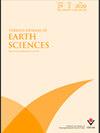土耳其安纳托利亚西南部Anamas块体边界断裂特征及古地震学行为
IF 1.1
4区 地球科学
Q3 GEOSCIENCES, MULTIDISCIPLINARY
引用次数: 0
摘要
:阿纳马斯地块位于伊斯帕塔角的顶点,伊斯帕塔是安纳托利亚最重要的构造结构之一。伊斯帕塔角具有复杂的构造结构,是由白垩纪晚期持续至今的挤压和伸展构造事件形成的。GPS和运动学数据表明,由于正断层(Beyşehir Gölü和Sarıidris)的影响,Anamas地块目前顺时针旋转,东边界和西边界上有一个较小的右侧走滑分量,而正断层(Gelendot)从北边界将Anamas地块向东南移动。在这项研究中,对Sarıidris、Gelendot和Beyşehir Gölü断层进行了古地震学沟槽调查。在沟壁上收集了三条断层在更新世晚期全新世期间的活动和断层运动学数据。在Sarıidris、Beyşehir Gölü断层上观测到一次地震,在Gelendot断层上观察到两次地震的沉积学和结构证据,这两次地震在晚更新世-全新世期间导致了地表破裂。本文章由计算机程序翻译,如有差异,请以英文原文为准。
Characteristic features and paleoseismological behaviours of the Anamas Block Boundary Faults, Southwestern Anatolia, Turkey
: The Anamas Block is located at the apex of the Isparta Angle which is one of the most important tectonic structures of Anatolia. The Isparta Angle, which has a complex tectonic structure, was formed as a result of compressional and extensional tectonic events that initiated from the Late Cretaceous continuing to the present. The GPS and kinematic data indicate the Anamas Block currently rotates clockwise due to the impact of the normal faults (Beyşehir Gölü and Sarıidris) with a minor right lateral strike-slip component on the east and west boundaries, while it is moved to the southeast by the effect of the normal fault (Gelendost) bounding the block from the north. In this study, paleoseismological trench investigations were carried out on the Sarıidris, Gelendost and Beyşehir Gölü faults. Data related with activity and fault kinematics of all three faults during the Late Pleistocene-Holocene period was collected on the trench walls. Sedimentological and structural evidences were observed for one earthquake on the Sarıidris, Beyşehir Gölü faults, and two earthquakes on the Gelendost Fault, which resulted in surface rupture during the Late Pleistocene-Holocene period.
求助全文
通过发布文献求助,成功后即可免费获取论文全文。
去求助
来源期刊

Turkish Journal of Earth Sciences
地学-地球科学综合
CiteScore
2.40
自引率
10.00%
发文量
6
审稿时长
6 months
期刊介绍:
The Turkish Journal of Earth Sciences is published electronically 6 times a year by the Scientific and Technological Research
Council of Turkey (TÜBİTAK). It is an international English-language journal for the publication of significant original recent
research in a wide spectrum of topics in the earth sciences, such as geology, structural geology, tectonics, sedimentology,
geochemistry, geochronology, paleontology, igneous and metamorphic petrology, mineralogy, biostratigraphy, geophysics,
geomorphology, paleoecology and oceanography, and mineral deposits. Contribution is open to researchers of all nationalities.
 求助内容:
求助内容: 应助结果提醒方式:
应助结果提醒方式:


